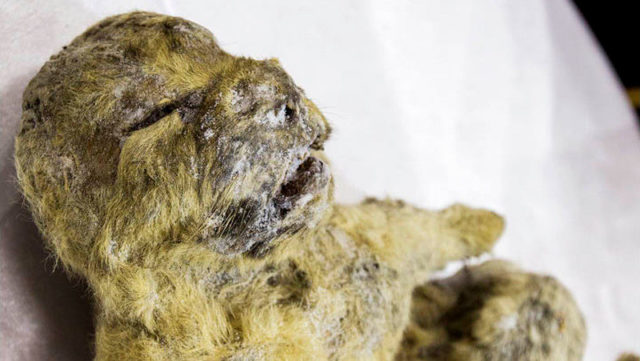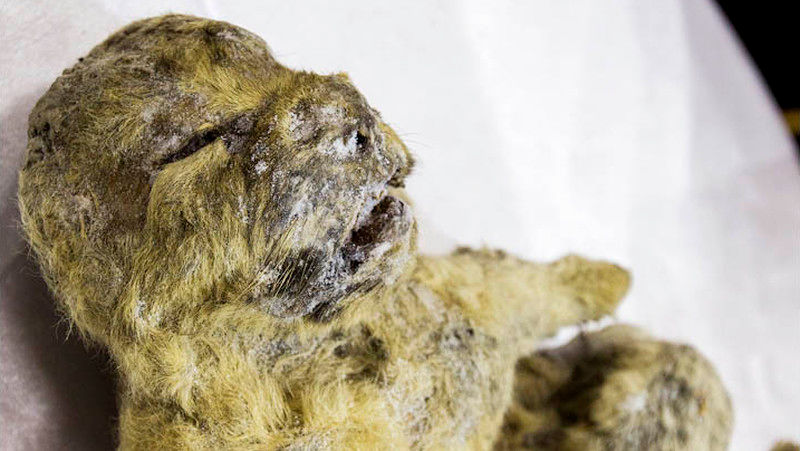Thanks to ice and snow, archaeologists have found remains of humans and animals almost completely preserved. The frigid ice allows the remains to decay slowly. Just recently, Russian scientists found two ancient lion cubs in the Siberian permafrost. By studying the cubs, they believe they might have found traces of the world’s oldest mother’s milk.
The cubs are believed to have been frozen for about 12,000 years. The researchers think that there could be traces of the breast milk on the extinct predators that trace back to the prehistoric times. In Yakutsk there will be an autopsy done on one of the large cats – it will take place in the hope that it will confirm the researchers’ beliefs.
One newspaper report stated that the experts don’t want to draw any premature conclusions, but they do have reason to believe that the intestines of the cubs will contain the white fluid from a deceased lactating lioness. One of the cats will be autopsied and the other will be preserved for future studies. The other cub will be kept in hopes that the future scientific advancements will allow them to understand more about the species who had once roamed the Eurasian land mass all the way from the British Isles to the far east of Russia.

The head of the mammoth fauna studies department of Yakutian Academy of Sciences, Dr. Albert Protopopov, said that the cubs were dug up last year from their grave. They were found complete with all of their body parts, including fur, ears, soft tissue, and even whiskers.
The Russian scientists allowed South Korean cloning expert, Hwang Woo-suk, to take samples from the cub during the autopsy. Woo-suk also hopes he can one day clone the extinct woolly mammoth. There were skin and muscle tissue extracted from the little creature’s remains. The scientist’s aim was to find living cells which could help scientists and researchers eventually bring the extinct lions back to life.
When Russian scientists were out researching on the permafrost, they realized there was a sudden rise and fall in the level of the Uyandina River. This led to several cracks appearing in the ice. That’s when one local worker, Yakov Androsov, with the help of a special ice lens, had spotted the lion cubs inside the ice.
Protopopov said that when he and the scientists revealed the animals to the media, they had to compare it to the modern lion everyone knows. With that idea, they compared modern cubs to the ancient cubs, which caused them to guess that the babies were only a week or two old.
He explained that the cubs’ eyes were still not quite open when they died. They also have some of their baby teeth; not all of them had grown in quite yet. Protopopov also believes that the babies had died after their mother hid her cubs in a cave in order to protect them from other hungry lions.
Cave lions, known as Panthera spelaea, lived during the Middle and Late Pleistocene times on the Eurasian continent. They lived from the British Isles to Chuktka in the extreme part of eastern Russia. They were also believed to have roamed Alaska and northwestern Canada.
The research that will be done could help experts discover why the entire species had died out around 10,000 years ago. Considering the lion didn’t have many predators at the time, it’s interesting they died out so fast. Another interesting factor is that the lions could have survived even getting bogged down in swamps, unlike the woolly mammals and rhinos.
A theory the scientists put forth is that there was a major decline in deer and cave bears, which were the lions’ prey. This caused the lions to go hungry and eventually die out.
Remains such as these are a very rare find; this makes the discovery of these lion cubs even more special. Before these little guys were found, the only other remains that date back this far have been skeletons and mere fragments of carcasses.
The discovery will help give scientists a better idea of what the animals that once walked Yakutia looked like. Up until now, the only impressions people have gotten were based on skulls, teeth, and bones found in those regions.
